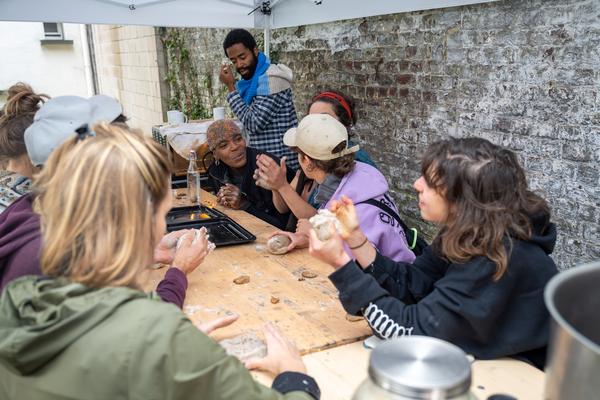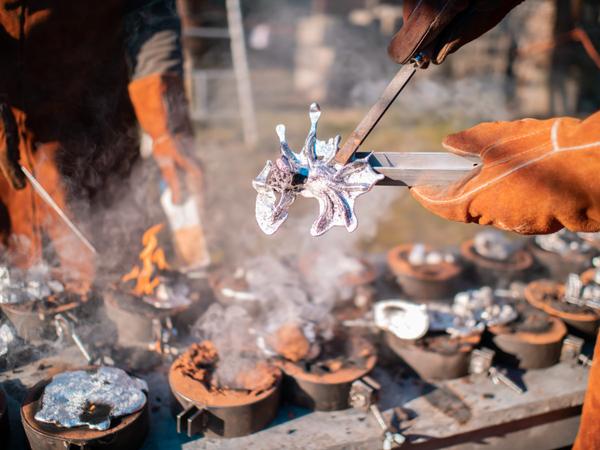Practical information
| Sep | 2024 | 14h00 | 18h00 |

Let's do it
- workshops
5 workshops to choose from
Traces













14:00 > 18:00

#1 Anyuta Wiazemsky Snauwaert (RU/BE), A ceremony for new Belgian citizens (in English)
Inspired by the book Coping Rituals in Fearful Times edited by Jeltje Gordon-Lennox, this workshop will focus on collectively brainstorming a proposal for a new ceremony dedicated to new Belgian citizens. How can we honor the effort that new Belgians and their significant others put into obtaining citizenship? What is the essence of citizenship in an age of wars, multiple crises, and inequality, and how can we translate this into hope for a convivial society? You will also get to bake and enjoy waffles, both savory and sweet and experiment with toppings.
Anyuta Wiazemsky Snauwaert is a multidisciplinary artist working in the visual arts, theater, and participatory art sphere. Their works revolve around the theme of intimacy, exploring it from various angles by delving deep into their own psyche, sharing personal experiences until they no longer feel intimate, or creating a sense of intimacy within the works themselves. Collaboration is a vital part of their practice, and they work alongside their life partner, Kim Snauwaert, under the name BETWEEN US.

#2 Stacy Makishi (UK), Walking Each Other Home (in English)
Walking Each Other Home – a workshop/ritual that welcomes you just as you are - especially the imperfect, messy, awkward, shy, shameful, shitty, "not good enough" parts of you. This participatory, creative, physical workshop explores stepping out into the "Unknown" together. What happens when our curiosity becomes larger than our fears? What happens to our hearts when we openly share our struggles? What does playfulness have to do with ritual? Let’s walk each other home, into the Unknown together.
Stacy Makishi is a transplant from Hawaii. Like a bonsai plant, Stacy is small but old. She has been making art for over 40 years. A cross-fertilization of live art, theatre, comedy, film and visual art, her work is as complex as it is accessible; humorous as it is challenging; visual as it is literate. Makishi believes in art’s transformative power and strives to share her creative process with others in order to put more "aloha" into the world.

#3 Back2SoilBasics (BE), Flour release (in French/English)
A collective moment to reflect on a dream: finding a new way of assessing living standards through the parameter of human needs, based on the 9 fundamental needs defined by the economist Max-Neefs. After going through these concepts in a circular fashion, we'll translate the knowledge we've gathered, our hands covered in flour.
Back2SoilBasics is a network of people guided by the power of mother nature. Their practice is based around earth regeneration through mind, soul and soil knowledge. They share basic tools for permaculture in an urban context as a resilient practice made accessible. They focus on people of colour, local communities or people with less access to nature. Their approach is to create an open school session where each person is part of a valid information exchange.

#4 Désorceler La Finance (BE), Speculation-lab: unbewitch the future city’s fiction (in French)
Désorceler la finance (Unbewitch Finance) offers a workshop-ritual of speculative fiction. By blending retro-futuristic projections and magical practice, between an internal voyage and role playing games, we will speculate a future Brussels, and will inspect what is hidden behind capitalist dreams. We will conduct a collective "investigation" around the transformations of the canal and the tensions that threaten the right to the city. Together, we will walk through the narrative-landscape of the "city of the future" as imagined by investors and real estate speculators, and we will suffocate it with our counter-narratives.

#5 La Fonderie (BE), Initiation to metalwork (in French)
La Fonderie will offer us a workshop exploring the process of sand casting. This technique takes advantage of the malleability of sand to create a mold from the impression of a plaster model. After tightly packing the sand around the model placed in a metal frame, the frame is turned over and the plaster is removed. Next, each participant traces, in two or three dimensions, the patterns that will characterize their mold. Near the old casting hall of La Fonderie, participants then watch the metal being poured into their molds. Each person will leave with their own aluminum object.